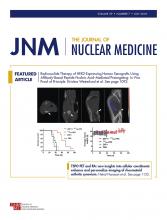PSMA biology: O’Keefe and colleagues survey the evolution of knowledge on the biology of prostate-specific membrane antigen and its translation to therapy, including PSMA-based imaging and endoradiotherapeutic strategies.
Page 1007
Dose matters: Duncan and colleagues detail agreement with Biologic Effects of Ionizing Radiation VII, which upheld the linear no-threshold model of low-dose exposure to ionizing radiation, and contrast this viewpoint with that of an article in this month’s JNM.
Page 1014
BEIR VII and the LNT: Siegel and colleagues offer critical reevaluation of the Biologic Effects of Ionizing Radiation VII report and the data on which its conclusions were based, calling for reassessment of the linear no-threshold model and associated policies.
Page 1017
a-Emitters for radiotherapy: Poty and colleagues, in the second of 2 educational reviews, provide an overview of the most promising and current uses of α-emitters in preclinical and clinical studies, highlighting the importance of clinical trial design.
Page 1020
Potential value of PET/MR: Miles and colleagues describe the ways in which a multiparametric PET/MR imaging approach might add clinical value through precision medicine and as a cost-effective oncology imaging modality.
Page 1028
Response to 177Lu-PSMA therapy: Ahmadzadehfar and Essler offer editorial comment on predictive factors associated with response and overall survival in castration-resistant metastatic prostate cancer after 177Lu–prostate-specific membrane antigen therapy.
Page 1033
Dual-acquisition PET in breast cancer: Humbert and colleagues use a single 18F-FDG dual-acquisition PET study to simultaneously assess tumor SUVmax and tumor blood flow to identify correlations with tumor phenotypic features and pathologic complete response.
Page 1035
90Y radioembolization for HCC with PVT: Abouchaleh and colleagues report on survival outcomes in patients with advanced-stage hepatocellular carcinoma with portal vein thrombosis treated with 90Y radioembolization.
Page 1042
PET reconstruction and Deauville score: Enilorac and colleagues investigate whether choice of reconstruction algorithm affects Deauville scores and whether discordance affects the ability of 18F-FDG PET to accurately stratify patients with diffuse large B-cell lymphoma.
Page 1049
Mesothelin imaging agents: Montemagno and colleagues report on radiolabeling and preclinical evaluation of 99mTc-A1 and 99mTc-C6, antimesothelin single-domain antibody–derived imaging agents, and describe potential uses in triple-negative breast cancer and other mesothelin-positive tumors.
Page 1056
FOLFOX combination therapy in CRC models: Schelhaas and colleagues perform sequential 18F-FLT PET and diffusion-weighted MR imaging to evaluate changes, including thymidine metabolism and DNA damage response, induced by a FOLFOX-like combination chemotherapy in colorectal cancer xenografts.
Page 1063
PSMA PET bone metastasis quantification: Hammes and colleagues introduce and validate Evaluation of Bone Involvement, a software tool to automatically quantify bone metastasis load in prostate-specific membrane antigen PET/CT imaging.
Page 1070
18F-PSMA-1007 and 18F-DCFPyL: Giesel and colleagues present an intraindividual comparison to evaluate tracer-specific characteristics of 18F-DCFPyL and 18F-PSMA-1007, prostate-specific membrane antigen–targeted PET/CT tracers, in patients with prostate cancer.
Page 1076
Fasting and 18F-DCFPyL uptake: Wondergem and colleagues report on a study to determine the impact of preimaging fasting on 18F-DCFPyL uptake on PET/CT in suspected lesions in patients with prostate cancer.
Page 1081
SSTR-RADS 1.0 for SSTR PET: Werner and colleagues propose a structured reporting system on a 5-point scale for somatostatin receptor PET imaging that could serve as a standardized assessment for both diagnosis and treatment planning in neuroendocrine tumors.
Page 1085
Affibody-based pretargeting: Westerlund and colleagues test the hypothesis that Affibody-based peptide nucleic acid–mediated pretargeted therapy of human epidermal growth factor receptor 2–expressing cancer extends survival without renal toxicity.
Page 1092
Antidepressants and 123I-MIBG uptake: Werner and colleagues evaluate in vitro and in rabbits whether the 4 classes of antidepressants most prescribed as first-line treatment for major depressive disorder have the potential to alter 123I-MIBG imaging results.
Page 1099
Kinetic protocol for 18F-florbetaben PET: Bullich and colleagues validate a noninvasive kinetic modeling approach for 18F-florbetaben PET and assess the impact of cerebral blood flow changes and radiotracer clearance on SUVRs and noninvasive kinetic modeling data.
Page 1104
Structural MR generation: Choi and Lee describe development of a model to generate structural MR images from amyloid PET imaging using deep generative networks, with an example of quantification of cortical amyloid load without structural MR.
Page 1111
Pediatric brain metabolism models: Turpin and colleagues develop mathematic models of regional relative brain metabolism using pediatric 18F-FDG PET with CT data from normal pediatric brains, accounting for sex and age and facilitating accurate prediction of regional pediatric brain metabolism.
Page 1118
TSPO in RA pannus: Narayan and colleagues use 11C-PBR28 PET to investigate translocator protein expression in major cellular constituents of rheumatoid arthritis pannus to more accurately interpret TSPO PET signal from rheumatoid arthritis synovium.
Page 1125
Whole-body personalized dosimetry: Lee and colleagues propose a novel method, the multiple voxel-S-value approach, for whole-body voxel-based personalized radiopharmaceutical dosimetry in heterogeneous media with nonuniform activity distributions.
Page 1133
Whole-body imaging during TNF SIRS: Delvaeye and colleagues demonstrate that noninvasive 99mTc-duramycin SPECT imaging can characterize the temporal and spatial kinetics of injury and cell death in susceptible tissues during tumor necrosis factor–induced systemic inflammatory response syndrome.
Page 1140
Evaluation of Lx-ADCs using 195mPt/89Zr: Muns and colleagues characterize Lx (a promising metal–organic linker) antibody–drug conjugates for in vivo stability and tumor targeting using dual labeling with 195mPt and 89Zr.
Page 1146
Penalized reconstruction evaluation: Lindström and colleagues compare block-sequential regularized expectation maximization with time-of-flight ordered-subsets expectation maximization in 18F-FDG PET/CT, both quantitatively and in a qualitative visual evaluation.
Page 1152
MR-compatible blood sampler: Napieczynska and colleagues validate the use of an MR-compatible blood sampler with a detector system based on a lutetium oxyorthosilicate scintillator and avalanche photodiodes for small-animal PET.
Page 1159
- © 2018 by the Society of Nuclear Medicine and Molecular Imaging.







